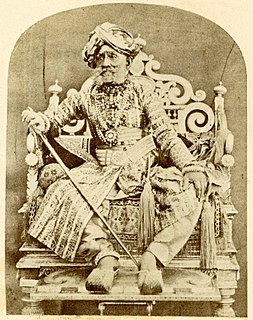 W
WMaharaja of Mysore was the principal title of the ruler of the Kingdom of Mysore in India until the abolition of the monarchy in 1950; the head of the royal family from 1950 to 1971; and, unofficially, the head of the erstwhile royal family following the removal of titles and privileges in 1971.
 W
WHyder Ali, Haidarālī was the Sultan and de facto ruler of the Kingdom of Mysore in southern India. Born as Hyder Ali Khan, he distinguished himself militarily, eventually drawing the attention of Mysore's rulers. Rising to the post of Dalavayi (commander-in-chief) to Krishnaraja Wodeyar II, he came to dominate the titular monarch and the Mysore government. He became the de facto ruler of Mysore as Sarvadhikari by 1761. He offered strong resistance against the military advances of the British East India Company during the First and Second Anglo–Mysore Wars, and he was the innovator of military use of the iron-cased Mysorean rockets. He also significantly developed Mysore's economy.
 W
WDevaraja Wodeyar II was the fourteenth maharaja of the Kingdom of Mysore from 1673 to 1704. During this time, Mysore saw further significant expansion after his predecessors. During his rule, centralised military power increased to an unprecedented degree for the region.
 W
WKrishnaraja Wodeyar I was the sixteenth maharaja of the Kingdom of Mysore. His reign lasted for 18 years, from 1714 to 1732.
 W
WMaharaja Jayachamarajendra Wadiyar ; 18 July 1919 – 23 September 1974), was the twenty-fifth maharaja of the Kingdom of Mysore from 1940 to 1971, ruling from 1940 until the monarchy was abolished in 1950, continuing to hold the title of maharaja until princely titles were abolished in 1971, and remaining head of the erstwhile royal family with the unofficial title of maharaja thereafter through his death. He was a noted philosopher, musicologist, political thinker, and philanthropist.
 W
WTipu Sultan, also known as Tipu Sahab or the Tiger of Mysore, was the ruler of the Kingdom of Mysore based in South India and a pioneer of rocket artillery. He introduced a number of administrative innovations during his rule, including a new coinage system and calendar, and a new land revenue system which initiated the growth of the Mysore silk industry. He expanded the iron-cased Mysorean rockets and commissioned the military manual Fathul Mujahidin. He deployed the rockets against advances of British forces and their allies during the Anglo-Mysore Wars, including the Battle of Pollilur and Siege of Seringapatam. He also embarked on an ambitious economic development program that established Mysore as a major economic power, with some of the world's highest real wages and living standards in the late 18th century.
 W
WThe Wadiyar dynasty was a noble family descended from herders in the Indian subcontinent that ruled the Kingdom of Mysore from 1399 to 1950, with an interruption. They were a feudatory house under Vijayanagar Emperor, took advantage of weakening Vijaynagar Empire and became free. Raja Odeyar, secured Srirangapatna in 1610, which was the seat of the Vijaynagar Viceroy. The kingdom was incorporated into the Dominion of India after its independence from British rule. From 1399 to 1610, Wodeyars were of Lingayat faith and promoted it as their state religion.
 W
WMaharaja Krishnaraja Wadiyar IV (Nalwadi Krishnaraja Wadiyar; 4 June 1884 – 3 August 1940) was the twenty-fourth maharaja of the Kingdom of Mysore, from 1894 until his death in 1940. At the time of his death, he was one of the world's wealthiest men, with a personal fortune estimated in 1940 to be worth US$400 million, equivalent to $7 billion at 2018 prices. He was the second-wealthiest Indian, after Mir Osman Ali Khan, Nizam of Hyderabad.
 W
WMaharaja Chamarajendra Wadiyar X was the twenty-third maharaja of the Kingdom of Mysore, between 1868 and 1894.
 W
WMaharaja Krishnaraja Wadiyar III was the twenty-second maharaja of the Kingdom of Mysore. Also known as Mummadi Krishnaraja Wadiyar, the maharaja belonged to the Wadiyar dynasty and ruled the kingdom for nearly seventy years, from 30 June 1799 to 27 March 1868. He is known for his contribution and patronage to different arts and music during his reign. He was succeeded by his adopted son, Chamarajendra Wadiyar X.
 W
WSrikantadatta Narasimharaja Wadiyar was the twenty-sixth head of the erstwhile royal family of the Kingdom of Mysore.
 W
WYaduveer Krishnadatta Chamaraja Wadiyar is the twenty-seventh head or "custodian" of the erstwhile ruling family of the Kingdom of Mysore and head of the Wadiyar dynasty, descendants of the herders, a branch of the Yaduvanshi clan within the Chandravanshi lineage. Although he has no official title or role, he is known as Maharaja of Mysore.